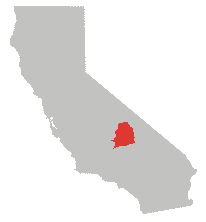THE TUBATULABALby Walter S. Nicholas Feb. 18, 1997
The Tubatulabal was one of over 100 tribes of Shoshonean-speaking people numbering as many as 133,000 individuals. They were of Shoshone stock and came into the Kern River Valley from the east. The Tubatulabal, a sub-group of the Uto-Aztecan family, moved into the area as early as 1,000 B.C. Three distinct bands which all spoke the same language once made up the Tubatulabal Tribe:
The word Tubatulabal means "a people that go to the forest to gather tubat (piñon nuts)." This was the name for the Tribe as well as for its language. They were known as "happy talkers" because their language was so lilting and full of laughter. The Tubatulabal were a peace-loving tribe that were in the Johnsondale area probably only during the summer months. They moved around quite a bit in search of food, but they made semi-permanent camps in the foothills. Their hamlets were always located by fresh water and sometimes a spring. Availability of firewood was always taken into consideration. Since they lived by hunting game and gathering native plants and seeds, their life was closely woven around the harvest of the products.
FoodWhat did the Tubatulabal eat? The bulk of their meat diet came from rabbits, deer and fish while whole acorns comprised a very large part of the plant food obtained, followed by piñons and a variety of small seeds. They also hunted and ate mountain sheep, brown bear, mountain lion, wildcat, mule deer, raccoon, gray squirrel, blue squirrel, golden mantle ground squirrel, small chipmunk-like ground squirrel, mallard ducks, mud hens, mountain and valley quail, band-tailed pigeon, white-faced goose, blue-winged teal, and canvasback ducks. The Tubatulabal usually began their day eating meat and acorn mush. The acorns, from oak trees, made up about 40% of the food they consumed or about 1,000 pounds per family annually. You have no doubt seen the bed-rock mortars or Indian grinding stones around the Ranch. This is where the acorns were pounded into a flour or meal after they were hulled. These pit mortars are found along many of the streambeds in the Kern River Valley and are the only evidence left of the many Indian village sites. The holes in the large flat rock were usually eight to ten inches deep and three to five inches wide. The pestles or stones used to pound the acorns in the hole were usually eight to fourteen inches long and two and a half to five inches wide depending on the size of the bed-rock mortar. The acorns were pounded into a course meal, the consistency of course flour, and then taken to the side of a stream to have the bitter tannin leached from it by pouring hot and cold water over it while it was in a wet sand pit. After the leaching, the acorn meal was left covered overnight with deerskin until the meal dried. The loaf or cake was then lifted out of the pit where it had been leached. Some of the acorn bread was eaten from the loaf without being cooked, but most of it was cooked into a thick mush or soup.
DwellingsThe Tubatulabal lived in dome-shaped willow and tule huts about 20 feet in diameter. There was a two foot hole at the top to allow light into the dwelling and to let smoke escape. The doorway faced east to catch the rising morning sun. The frame was made of willow poles ten feet tall placed around the 20 foot diameter circle and horizontal, two-inch thick willow bands. Brush was piled on the frame and then covered with mud. A layer of tules six to eight inches thick finished off the outside of the house. A tule mat was hung over the door. Tule mats were also used to sleep on with rabbit-skin blankets. It took forty jackrabbit skins to make a blanket 6 by 8 feet.
From A Short History of Johnsondale
|
 Some 30,000 to 50,000 thousand years ago, during the Ice Age, the forefathers of the Indians who lived along the Kern River crossed the land bridge between the Orient and North America. Indians have lived in the Kern River Valley for the last 3,000 years, whereas the white man arrived only in the 1850s. The Indians who lived in this area are known as the Tubatulabal Tribe.
Some 30,000 to 50,000 thousand years ago, during the Ice Age, the forefathers of the Indians who lived along the Kern River crossed the land bridge between the Orient and North America. Indians have lived in the Kern River Valley for the last 3,000 years, whereas the white man arrived only in the 1850s. The Indians who lived in this area are known as the Tubatulabal Tribe.